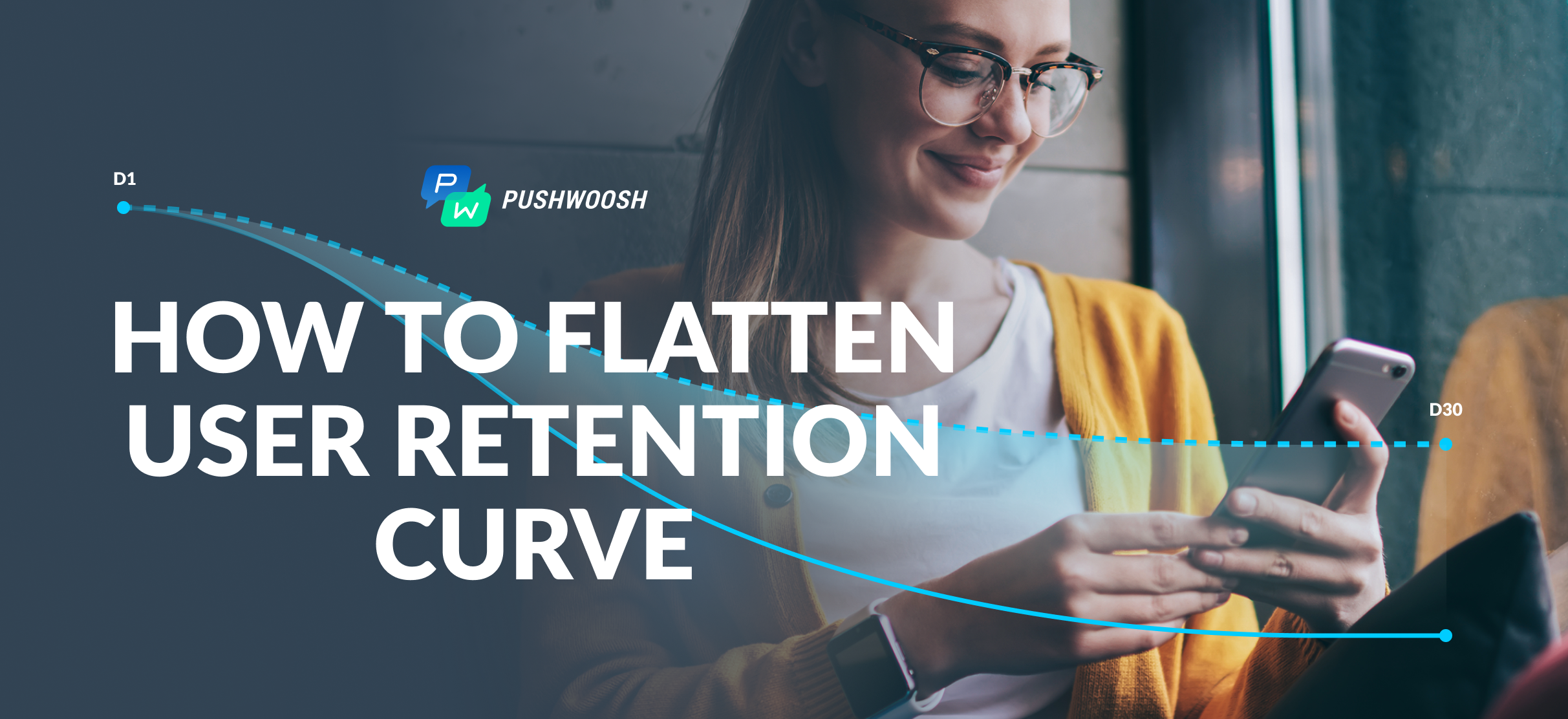Improving user retention can be challenging, like trying to fill a leaky bucket. Even if you attract new users quickly, they will still churn. Many mobile apps lose the majority of users between Day 1 and Day 30, but luckily, there are ways to combat this. Strategic messaging techniques can help retain users and keep the user retention curve steady.
What is the user retention curve?
A retention curve is a graph that visualizes your app’s retention over time. It shows the percentage of users who continue interacting with the app after the first use.
How to generate a retention curve
Many analytics tools such as Amplitude and Mixpanel, as well as customer engagement tools such as Pushwoosh provide features to create a retention curve for your app. You can generate your graph for needed periods of time depending on your app’s type and see whether you need to improve your customer retention.
Why is the user retention curve important?
Translating retention metrics into a graph is the best way to see how well you are retaining users. At the start, the graph will always trend downwards, as some users inevitably drop off in the initial stages of app usage. When the curve levels off at some point it indicates that you effectively communicate the app’s value to your users, encouraging their long-term engagement.
Looking at the user retention curve
What are the types of user retention curves?
- Flattening curve. This type shows ideal retention. The curve plateaus at a certain percentage, indicating that you've achieved a low churn rate and strong retention.
- Steep curve. This type indicates suboptimal retention with a decrease in user engagement over time. This pattern suggests challenges in retaining users, highlighting issues with engagement strategies or the overall user experience.

The chart shows a significant decrease in user retention after Day 0 with the solid black line. The dotted line, on the other hand, indicates a more positive trend.
How to flatten the user retention curve
We can see that the graph above is split into three optimizable flow stages to encourage a user through the journey and become fully engaged. These stages include onboarding, value discovery (also known as the Aha! moment), and habit formation.
To flatten the user retention curve, you can optimize these stages step by step by incorporating an on-point triggered messaging strategy.
Click on the name of the stage to jump straight to the tips for its optimization.
✅ Onboarding: Integrating tutorials and interactive walkthroughs can encourage more completed signups. Winning this stage will have a knock-on effect for the rest of the user journey.
👀 Value discovery: Prove your app is worth it! Make sure users experience your app's value and useful features as much as possible. Segmented emails and push notifications will encourage activation events.
💪 Habit formation: Use external triggers, motivation, and gratification techniques to develop habits in users and keep them coming back to your app.
You need to flatten your retention curve. But to do that, you need to understand what happens before people are retained. Break down your retention curve into different stages and learn what happens before users become engaged: onboarding, value discovery (Aha!), habit formation, and current user.
Now that we understand the breakdown of the user flow, we can look into optimizing each stage by creating a personalized and automated communication strategy.
First, let’s look at how you can improve the onboarding phase and retain more users in the long term.
Onboarding: Boost retention on Day 1 and beyond
Retention is a marathon, not a sprint — that’s exactly the issue. If you’re looking to elevate the retention graph at later stages, you may have to wait for Days 7 to 30 of the user journey to employ any improvements. How discouraging and unproductive it may feel!
Luckily, there is a way to get faster results. An optimized onboarding experience can reshape the entire trajectory of the user journey, giving immediate and impactful results.

Head of Product at Pushwoosh
View the app onboarding optimization as a quick win: Invest in a few experiments at that initial stage and see how improved retention on Day 1 to Day 3 carries along an uplift in retention at subsequent stages.
Now, how do you streamline and optimize an app's onboarding process? There are multiple ways, including:
- Leveraging personalized welcome messages for new users.
- Take users on an interactive tour across the app, educating them on features.
- Experimenting with different onboarding scenarios for separate user cohorts.
You can implement any onboarding strategy with Pushwoosh Customer Journey Builder. On its canvas, you can:
🔀 Plan, automate and launch omnichannel communication flows
📱 Manage interactive in-app messaging walkthroughs
👀 Send push notifications to gain new users’ attention
Below is an example of an onboarding flow you can build on the canvas of Pushwoosh Customer Journey Builder. Scroll down for its text description.

- A user signs up to the app—the event triggers a Journey start.
- The user receives guidance through a series of in-app messages. Their content may vary from a product tour to a preferences survey, depending on your goals and app specifics.
- Once a user has passed the initial onboarding, consider giving them some time before sending the next communication.
- Wait until they open the app again. If they do, welcome them back, for example, with a feature they can try. If they don’t return after the specified time, you can trigger a push notification encouraging them to explore your app further.
- Wait for the user to click on your push notification and experiment with the suggested feature.
- If the user didn’t respond to the push notification, you can set up a trigger, waiting for them to open the app for 7 days.
- When the user reopens the app, send an in-app message welcoming them back and highlighting a feature they haven’t tried.
An inspiring example: Omada, a coupons and discounts service app, improved its onboarding to elevate its long-term (Day 30) retention by 4%. It became possible with a step-by-step boost of intermediate metrics:
👆 Conversion to activation action reached 67.4%;
🤝 Day 12 Retention reached 29%.
Omada’s success story proves the point: if you’re looking to flatten your retention curve, a smart idea is to optimize its early stages.
You can give a similar boost to your retention metrics too. Sign up to Pushwoosh for free now and try out our powerful Customer Journey Builder.

Value discovery: Activate users so they want to retain
Once you’ve optimized your onboarding stage by using personalized messaging, it’s time to highlight the most valuable features of your app to increase activation rates. In this phase, you want users to think, “Aha! I need this app in my life!”.
The challenge with increasing activation rates lies in keeping users motivated to continue using your app while all the competition also fights for their attention. Without a clear path to value, users are much more likely to lose interest and churn.
Measuring activation rates isn’t as simple as keeping track of the number of registrations or clicks. It’s more individual for each company, what their logic is, and what the goal of the app is. Think about:
- What actions should a user take to be defined as activated, and which in-app events will show you that users have performed those necessary actions?
- Will those events be different for specific user segments?
- If so, how are you going to distinguish those segments? For example, are you going to differentiate new users acquired organically from those who installed your app after clicking on a paid ad? Personalizing your messaging based on acquisition sources is one of the ways to engage and convert users more effectively.
Once you have the logic, you can plan targeted messaging to improve activation and retention:
- In-app messages offering a walkthrough, encouraging users to try different areas of your app.
- Emails to users who’ve been away for a defined amount of time and are yet to complete those sweet activation events. You can boost both value discovery and retention with exclusive promotions in your emails.
- Push notifications—arguably one of the most effective ways to engage users, leading them to complete an activation action with just one tap. Highlighting key features is a great way to take advantage of push notifications.
Of course, there’s quite a lot to plan and measure here, but luckily, Pushwoosh Customer Journey Builder can automate all the messaging flows and deliver statistics on activation events and other crucial touchpoints to the same interface. Let’s look at an example of setting that up:

- Target users who have passed through your optimized onboarding flow.
- Wait for them to take the activation action.
- If the activation event isn’t triggered, send an in-app message to the user to encourage that action.
- If the user doesn’t get activated and even stops engaging with the app, re-engage them with an email or a push notification highlighting your app’s value.
By delivering a clear message with your app’s value, you can make it a natural part of users’ day-to-day lives. As they start using your app more, you can see a higher session duration, feature adoption rate, and more conversions—all indicators of successful value discovery and user retention.
Experiment with messaging for the value discovery stage for free!

Habit formation: Retain users through external triggers, motivation, and gratification
Sustaining user engagement over time requires a little more than developing a one-off interest in your app. We need to create habitual interactions so that users keep returning to your app over time and elevate retention further down the curve.
This can be an uphill battle, as inconsistent user engagement is common and natural for many apps.
🛫Travel apps may have an average usage rate of just a couple of times a year. Between such rare app sessions, users may entirely forget about the app's existence, even if it stays installed on their phones.
💪 Educational and training apps require a conscious effort from users, making it challenging to sustain consistent usage over time. An app has to provide external motivation and help users establish new habits.
To instill a habit of using your app, you can employ engagement techniques:
External triggers can include strategies with push notifications and emails. They motivate users to interact with your app.
Gratification techniques imply giving the user a good feeling as soon as possible, preferably right after the app open. Social media apps like TikTok do this very well; at the entrance, it immediately displays an engaging video that’s linked to the users' interests.
Use Scheduled Launch to send repeating reminders to use your app daily or weekly. A push notification will arrive to the user’s phone at the specified time and prompt a user to complete the desired action.

You can also supplement these push triggers with in-app messages, for example, inviting users to begin a workout session to enhance motivation to use the app.
Let’s look at an example of setting up scheduled reminders for a fitness app in the Pushwoosh Customer Journey Builder:

You can craft scheduled campaigns with Pushwoosh tools and ingrain usage habits for your app.
As a result, you can expect to see improvements in user activation and retention, a higher frequency of app interactions, and a flatter user retention curve.
Flatten the user retention curve strategically with Pushwoosh
Mastering user retention can sometimes feel like fighting a losing battle, but armed with targeted messaging tools by Pushwoosh, you can flatten the user retention curve effectively.
Dissect the new user journey into distinct stages—onboarding, value discovery, and habit formation—and optimize each step with personalized communication strategies, paving the way for ongoing engagement and long-term retention.



